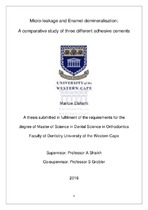Micro-leakage and Enamel demineralisation : a comparative study of three different adhesive cements
Abstract
Introduction: Micro-leakage and enamel demineralization is still a major challenge in dental practice. It can lead to formation of demineralization lesions around and beneath the adhesive–enamel interface (Mali et al., 2006). Enamel demineralization adjacent to orthodontic brackets is one of the risks associated with orthodontic treatment. The prevention of demineralization during orthodontic treatment is therefore essential for aesthetic reasons and to circumvent the onset of caries. Aim: To assess micro-leakage and enamel demineralization around orthodontic direct attachments (brackets) using three different orthodontic cements. Materials and methods: In this in-vitro study, intact (non carious) extracted human premolars were used to compare the micro-leakage and enamel demineralization of three different cements (Fuji Ortho LC, Rely X luting 2 and Transbond XT). The dye penetration technique was used to evaluate micro-leakage on extracted human premolars. Micro-hardness testing was performed on 21 teeth to determine enamel demineralization. Sixty teeth were randomly divided into 3 groups of twenty teeth each. Direct attachments were cemented on each tooth using 3 different cements; Fuji Ortho LC (GC Fuji II LC GC Corporation Tokyo, Japan), (group 1), Rely X luting 2 cement (3M ESPE dental product, USA), (group 2), Transbond XT Light Cure (3M Unitek, Monrovia, Calif), (group 3). After the orthodontic direct attachments were fitted, they were exposed to 500 thermo-cycles between 5°C and 55°C, with a dwell time of 15 seconds in a buffered (pH 7) 1% methylene blue dye solution (Grobler et al, 2007). The specimens were viewed under a stereomicroscope (Nikon, Japan) at magnification of 40 times. Photographs of each specimen were taken with a Leica camera (Leica DFC 290 micro-systems, Germany) fitted onto a stereomicroscope. The ACDsee photo editing programme was used to transfer the photographs to a computer to measure the dye penetration along the enamel–adhesive and adhesive–bracket interfaces, both on the gingival and occlusal edge at × 40 magnification. For the demineralization sample, 21 teeth were divided into 3 groups of seven teeth each, where direct attachments were cemented using each of the 3 cements, group 1, Fuji Ortho LC (GC Fuji II LC GC Corporation Tokyo, Japan); group 2, Rely X luting 2 cement (3M ESPE dental product, USA) and group 3, Transbond XT Light Cure (3M Unitek, Monrovia, Calif). A digital hardness tester with Vickers diamond indenter (Zwick RoellIndentec (ZHV; Indentec UK) was used to measure surface micro-hardness of enamel before and after attaching the brackets. Ten indentations were made on the enamel surface of each tooth before bonding the brackets with a 300g load applied for 15 seconds to establish the baseline hardness value. After de-bonding the brackets, the hardness was measured again in the same area as mentioned above to determine the degree of enamel demineralization (softening). Result: The result showed statistically significantly lower levels of micro-leakage for Transbond XT (P= <0.001). The amount of micro-leakage on the margins was significantly higher in the gingival portion (P <0.05) as compared with the occlusal margin. Enamel micro-hardness tests before bonding using the three different cements showed that the variances are not significantly different (Chi-squared = 3.051, df = 2, p-value = 0.218). However, the micro-hardness tests done after bonding and thermo-cycling was statistically significantly different (Chi-squared = 13.435, df = 2, p-value = 0.001). Clearly, the Transbond XT group had less hardness, implying greater demineralization than the Fuji Ortho LC and Rely X luting 2 groups. Two sample t-tests show that mean value for the Fuji Ortho and Rely X luting 2 were not significantly different from each other (t = -0.636, df = 12, p-value = 0.537). The mean value for Transbond XT differed significantly from both the other two means: Transbond XT vs Fuji Ortho LC (t = 3.249, df = 6.9, p-value = 0.014). Transbond XT vs Rely X luting 2 (t = 3.493, df = 6.8, p-value = 0.011). Conclusions: This study showed that Fuji Ortho LC and Rely X luting 2 show more micro-leakage than Transbond XT. However Transbond XT had significant lower micro-leakage, less hardness (greater demineralization) than the Fuji Ortho LC and Rely X luting 2. This may have been due to the fluoride release which significantly reduces demineralization. Therefore the Fuji Ortho LC and Rely X luting 2 may be recommended for prevention of demineralization during orthodontic treatment.

